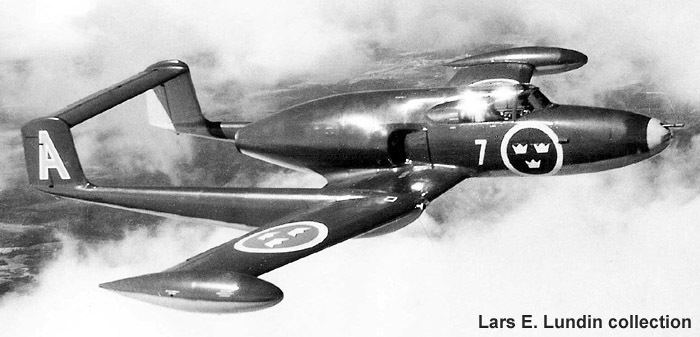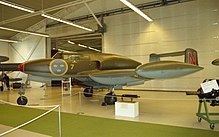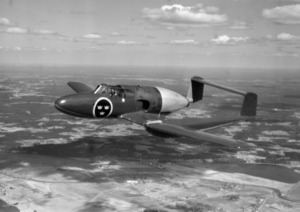Top speed 800 km/h Wingspan 11 m Weight 3,090 kg First flight March 10, 1947 | Range 720 km Length 10 m Engine type de Havilland Goblin | |
 | ||
The Saab 21R was a Swedish twin-boom fighter/attack aircraft made by Saab. It was a jet-powered development of the piston-engined Saab 21 which along with the Russian Yakovlev Yak-15 was one of the only two jet fighters successfully converted from a piston-powered aircraft.
Contents
- Design and development
- Changes from the J 21A version
- Operational history
- Variants
- Operators
- Specifications Saab 21RA
- References

As a fighter, its service designation in the Swedish Air Force was J 21R, and saw service in the late 1940s.

Design and development

In early 1945, Saab launched a project to determine how to provide the J 21A with a jet engine to get the experience of jet engines and flying at high speeds. The goal was to catch up with the development of jet aircraft, which were moving ahead fast in England, where, among others, de Havilland already had the de Havilland Vampire in production.

When the project started, the engine choice was an open question. However, as the project progressed it became possible to buy a "Goblin 2" jet engine from de Havilland Engine Company, along with the license to manufacture in Sweden. This engine became the Air Force's first Jet Engine, RM1. The rebuilt J 21A received type designation J21R. First flight with Saab's first jet took place on 10 March 1947.
Changes from the J 21A version
Because of the engine exhaust position, the stabilizer had to be raised, which meant that the tail had to be redesigned. Measures to improve the aerodynamic design of the aircraft were carried out, for example, curved front glass in the canopy and a refined wing leading edge. Airbrakes were introduced in the form of an upward and a downward flap on the outer wing's trailing edge. Ejection seat improvements were made to enable ejections at high speed. Fuel volume increased significantly with the use of tanks in the middle wing and large wingtip tanks.
The attack version A 21R added 14.5 cm attack rockets placed under the middle wing. Furthermore, an alternative external machine gun pod was created. A big sensation was that it was possible to fire all 13 weapons at the same time. This was an interesting "sensation" for the pilot as well.
A production of 124 planes was planned originally, including four prototypes. When experience with the type as a fighter was gained with the F10 wing it was concluded that all aircraft needed to be changed to attack aircraft. The production series was then reduced to 64 aircraft. Of these, 34 were J21RA fitted with the Goblin 2 engine, RM1, with 1360kp of thrust.
30 J21RB with a Swedish-made Goblin 3 engine, RM1A, with a thrust of 1500kp.
Operational history
The first prototype Saab 21R first flew on 10 March 1947, almost 2 years after the Second World War. The aircraft first entered service with F 10 in August 1950. Although the type was originally intended as a fighter aircraft, a newly developed fighter, the Saab J 29 first flew in October 1948, the number to be produced was halved from 120 to 60, and eventually all 21Rs were converted to attack aircraft as A 21RA or the A 21RB depending on the engine type.
Variants
Operators
Specifications (Saab 21RA)
Data from Attack and Interceptor Jets
General characteristics
Performance
Armament
